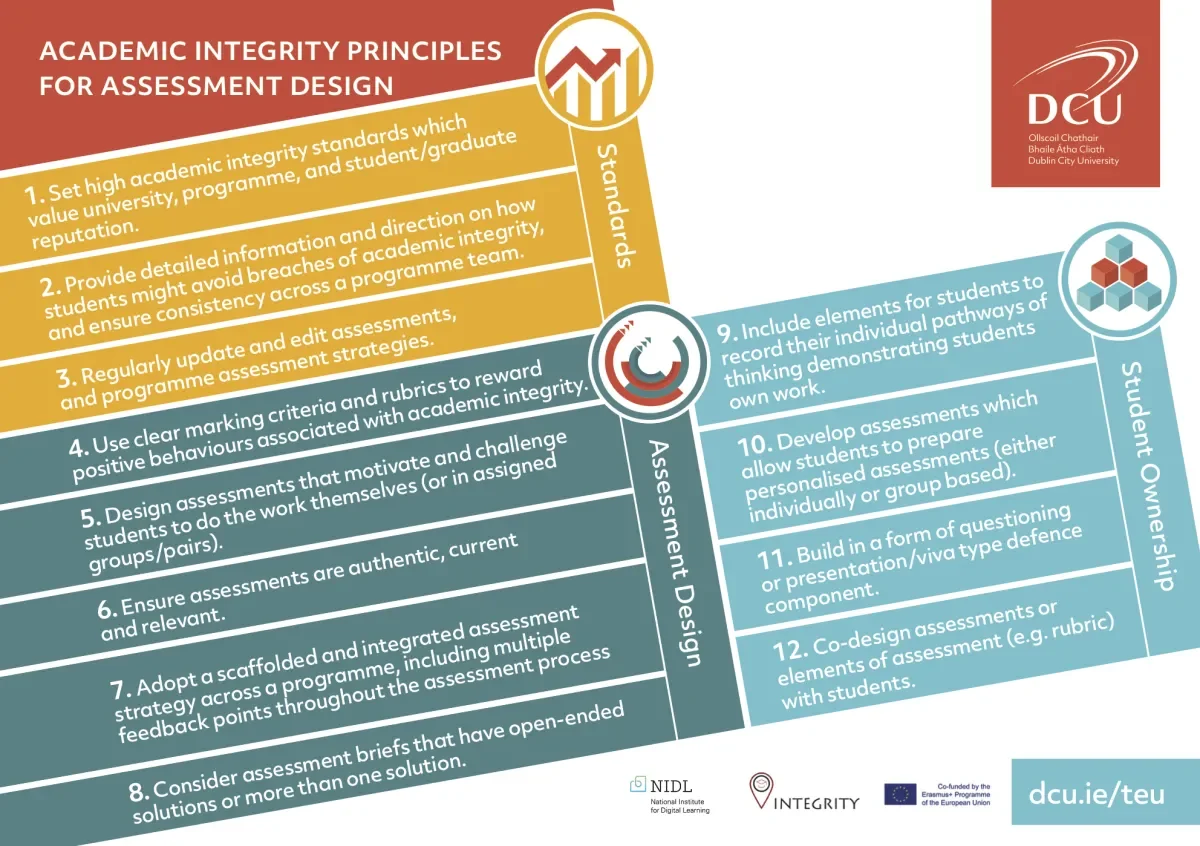
Academic Integrity Principles for Assessment Design

As part of an Erasmus funded project the TEU conducted a literature survey on assessment design as it relates to academic integrity with two questions guiding our research:
- What approaches to assessment design are used to promote or maintain academic integrity?
- What recommendations are being made on using assessment design to support academic integrity?
From this analysis and subsequent discussions with our counterparts in higher education in Ireland we derived 12 principles of academic integrity which we now use as a cornerstone when supporting our academics with respect to designing assessments. These 12 principles are divided into three categories: Institution Standards, Assessment Design and Student Ownership.
Please click here for case studies and examples for each principle.
1. Set high academic integrity standards which value university, programme, and student/graduate reputation.
Embed high academic standards into the programme and module, led by University supports and resources. Instil in the programme team, and students, that everyone is both responsible for maintaining high standards; and will reap the rewards of being known to be part of a programme with the highest academic integrity.
2. Provide detailed information and direction on how students might avoid breaches of academic integrity and ensure consistency across a programme team.
Support students to develop their own sense of personal integrity through use of. detailed rubric, examples or exemplars, guidance documents, policy etc. Use formative feedback to help students develop this form of personal integrity. Also, the programme team of lecturers must lead by example.
3. Regularly update and edit assessments and programme assessment strategies.
Review and update programme assessment strategy and assessment briefs every year. Blindly repeating assessment briefs or tasks encourages students to seek out previous years students for help (or collusion). As an example, the previous year’s assessment brief could be developed to include additional information on current advancements.
4. Use clear marking criteria and rubrics to reward positive behaviours associated with academic integrity.
Use rubric as class tutorial material. Also, consider designing in a separate reflection component/task with allocated marks in rubric. This can be related to principle twelve i.e. involving students in design of rubric.
5. Design assessments that motivate and challenge students to do the work themselves (or in assigned groups/pairs).
Include opportunities to allow students demonstrate their creativity, problem-solving and reflection competencies e.g. project or problem-based assessments. Students are also motivated to produce a valuable takeaway or artefact.
6. Ensure assessments are authentic, current and relevant.
Work or community-based assessment are authentic. Another way is to design integrated assessment strategies across a programme or stage. Alternatively, allow students to negotiate a bespoke assessment brief to suit their work/life experience.
7. Adopt a scaffolded and integrated assessment strategy across a programme, including multiple feedback points throughout the assessment process.
Inclusion of formative feedback throughout the assessment process supports and scaffolds assessment for learning by offering students opportunities along the way for self, peer or tutor feedback e.g. WIP (Work in Progress) or Crits.
8. Consider assessment briefs that have open-ended solutions or more than one solution.
When there is no one correct answer, it encourages students to be individual and prevents them from sourcing the solution. This approach combined with formative feedback would be excellent. This is of particular importance for high stake assessments i.e. award year and/or high allocation of overall marks.
9. Include elements for students to record their individual pathways of thinking demonstrating students own work.
ePortfolios or information maps are good examples of requiring students to record their individual pathways of thinking. These can be part of the formative assessment in addition to summative.
10. Develop assessments which allow students to prepare personalised assessments (either individually or group based).
Personalised assessments require some time to develop a bank of scenarios (case studies or problems) and a system to randomly allocate a different assignment brief to each student (or group). Technology could be leveraged to support this approach.
11. Build in a form of questioning or presentation/viva type defence component.
A summative element of the assessment where students have to ‘defend’ their work is an excellent way of promoting academic integrity because students will be unable to do this component unless they have prepared the assessment themselves e.g. group or individual presentation, poster presentation etc.
12. Co-design assessments or elements of assessment (e.g. rubric) with students.
Assessors could have a broad idea of mark allocation and use this as a tutorial class to co-develop the criteria and associated descriptors to co-design the rubric with students. This will have the effect of students sense of ownership and contributes to building capacity among the students for the assessment tasks.
